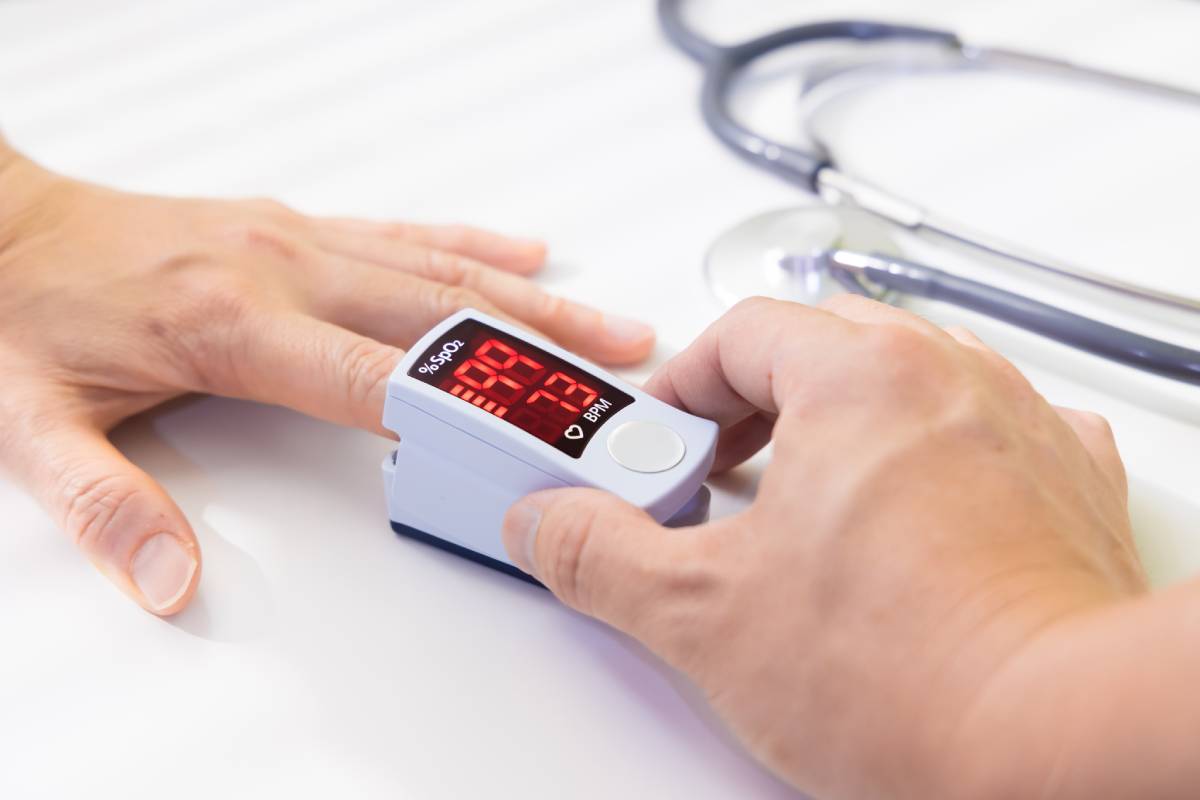How Is Blood Oxygen Measured?

Oximetry is a technique that uses differences in light absorption to measure blood oxygen saturation. Accurate measurements of oxygenation are critical, as oxygen levels provide information on patients’ health status. But how is blood oxygen measured?
Oxygen-rich and oxygen-depleted blood absorb light differently, and from spectroscopy data, the percentage of oxyhemoglobin can be determined. A pulse oximeter is attached to a fingertip or earlobe, and then light in the red spectrum (660 nm) and in the infrared spectrum (940 nm) is emitted onto the skin and into underlying tissue. A photodetector detects transmitted light, specifically what kind of light returns and how much, from which blood oxygen is measured.
Clinicians might measure blood oxygen saturation to monitor respiratory function, which is crucial for patients under anesthesia. Hypoxemia (low oxygen levels) is life-threatening and can occur during surgery since analgesics depress respiratory function; hypoxemia can indicate that the heart and circulatory system are not distributing oxygenated blood around the body effectively or that the exchange of oxygen in alveoli in the lungs has been compromised.1 Understanding which patients are at risk for inaccurate readings also prevents hypoxemia. Smokers are high-risk patients since carbon monoxide binds to hemoglobin and absorbs at a similar wavelength to oxyhemoglobin. This leads to higher measured blood oxygen saturation than is the case in reality. 2 Monitoring blood oxygen is also important for patients with lung or cardiovascular conditions.
Improving real-time assessment and clinician response to changes in blood oxygen saturation are critical to effective patient monitoring. In response to this need, Baloglu et al. developed a modified pulse oximeter that wirelessly transfers measured blood oxygen data to ventilators, respirators, AI devices such as fuzzy logic, and OS devices. Using the RPi Thonny Python interface, immediate relay of data is facilitated. The advantage of wireless data transfer is the simultaneous recording of blood oxygen readings and the transmission to critical instruments being used to monitor vitals and provide respiratory support. Such devices have the potential to improve response time in cases of urgent changes in status. 5
To further improve clinicians’ ability to assess blood oxygen saturation in the cardiovascular and hematological systems, researchers want to quantify the relationship between the aggregation of red blood cells and the simultaneous uptake or delivery of oxygen. This relationship accounts for the pulsating nature of blood flow, which can refine the way blood oxygen saturation is measured. To assess the dynamic of blood flow and blood oxygen saturation, high-frequency photoacoustic (PA) imaging is used; images are developed from high-frequency sound waves and ultrasound detection, to describe oxyhemoglobin levels. This technique assesses physiological blood flow and oxygen delivery by measuring both the aggregation of red blood cells and levels of oxygen saturation simultaneously.4
Blood oxygen levels often need to be measured at home, especially in patients recovering from or living with a chronic disease,. Smartwatches are a convenient way for patients to monitor their blood oxygen levels and can be more convenient than pulse oximeters. Jiang et al. assess the reliability and accuracy of four of these devices, the Apple Watch Series 7, Garmin Venu 2s, Garmin Fenix 6 Pro, and Withings ScanWatch. The Apple Watch Series 7 had a 58.3% accuracy, with a tendency to overestimate blood oxygen while the Garmin Venu 2s underestimated blood oxygen in 67.4% of the readings. Both the Garmin Fenix 6 Pro and Withings ScanWatch had the greatest inconsistency in producing readings. These were compared to the clinical device, Masimo MightySat Rx. Despite the convenience of these devices, patients should not rely on them exclusively for reliable results.6
References
- Nitzan, Meir, et al. “The Various Oximetric Techniques Used for the Evaluation of Blood Oxygenation.” Sensors, vol. 20, no. 17, Aug. 2020, p. 4844, doi:10.3390/s20174844.
- Lee, Wally W., et al. “The Accuracy of Pulse Oximetry in the Emergency Department.” American Journal of Emergency Medicine, vol. 18, no. 4, July 2000, pp. 427–31, doi:10.1053/ajem.2000.7330.
- Eliasdottir, Thorunn Scheving. “Retinal Oximetry and Systemic Arterial Oxygen Levels.” Acta Ophthalmologica, vol. 96, no. A113, Nov. 2018, pp. 1–44, doi:10.1111/aos.13932.
- Bok, Tae-Hoon, et al. “Simultaneous measurement of erythrocyte aggregarion and oxygen saturation under in vitro pulsatile blood flow by high-frequency photoacoustics.” 2014 IEEE International Ultrasonics Symposium, Chicago, IL, USA, 2014, pp. 1292-1295, doi: 10.1109/ULTSYM.2014.0319.
- Baloglu, Serafetdin, et al. “Design and Implementation of Pulse Oximeter Synchronized With Respirators.” 2022 57th International Scientific Conference on Information, Communication and Energy Systems and Technologies (ICEST), June 2022, doi:10.1109/icest55168.2022.9828719.
- Jiang, Yihang, et al. “Investigating the Accuracy of Blood Oxygen Saturation Measurements in Common Consumer Smartwatches.” Plos Digital Health, vol. 2, no. 7, July 2023, p. e0000296, doi:10.1371/journal.pdig.0000296.
